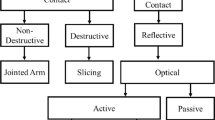Abstract
This paper investigates the potential use of a prototype micro-optic twin Liquid Crystal Display (LCD) monitor for stereomicroscopy in microsurgery. The new device displays stereoscopic images via a pair of colour Charge-Coupled Device (CCD) video cameras attached on to a surgical stereo microscope. The paper illustrates the 3D microscope-display system set-up and calibration for stereo viewing. A series of experimental techniques was devised to measure the user-response of the new display system in depth perception of a solid object against the traditional eyepieces of a stereo microscope. As a control, free viewing with the un-aided eyes was also measured. The positional data were collected using a passive mechanical arm. The results showed good correspondence between all three visualisation methods. Error analysis of our numerical findings suggests that the depth accuracy of the new device is well within the precision limits of hand movement for surgical operations. Our study also proves that there are small discrepancies within the sample population of operators using the system. A study based on the psychological and psychophysical factors influencing the system is planned.
Chapter PDF
Similar content being viewed by others
Keywords
These keywords were added by machine and not by the authors. This process is experimental and the keywords may be updated as the learning algorithm improves.
References
Bos, P.J.: Liquid-crystal shutter systems for time multi-plexed stereoscopic displays. In: McAllister, D.F. (ed.) Stereo Computer Graphics and Other true 3D Technologies, pp. 90–118. Princetown University Press, Princetown (1993)
Woodgate, G.J., et al.: Autostereoscopic 3D display systems with observer tracking. Signal Processing: Image Communication 14, 131–145 (1998)
Ezra, D., et al.: New autostereoscopic display system. In: Proc. SPIE 2409, pp. 31–40 (February 1995)
FaroArm Silver 8, Faro Technologies Inc., Florida, USA
Caliper 3D for Windows manual, Faro Technologies Inc., Florida, USA (1997)
Dodgson, N.A., et al.: Autostereoscopic 3D Display in Laparoscopic Surgery. In: Lemke, H.U., et al. (eds.) Proc. of CAR 1995, pp. 1139–1144. Springer, Berlin (1995)
Woodham, J., Javer, A.: ”Heads-Up-FESS”- working from the TV monitor. FESS Special Feature, ENT News 7(5), 19–20 (1998)
Curran, W., Johnston, A.: Three-dimensional Curvature Contrast-Geometric or Brightness Illusion? Vision Res. 36(22), 3641–3653 (1996)
Author information
Authors and Affiliations
Editor information
Editors and Affiliations
Rights and permissions
Copyright information
© 1999 Springer-Verlag Berlin Heidelberg
About this paper
Cite this paper
Chios, P. et al. (1999). The Potential Use of an Autostereoscopic 3D Display in Microsurgery. In: Taylor, C., Colchester, A. (eds) Medical Image Computing and Computer-Assisted Intervention – MICCAI’99. MICCAI 1999. Lecture Notes in Computer Science, vol 1679. Springer, Berlin, Heidelberg. https://doi.org/10.1007/10704282_109
Download citation
DOI: https://doi.org/10.1007/10704282_109
Publisher Name: Springer, Berlin, Heidelberg
Print ISBN: 978-3-540-66503-8
Online ISBN: 978-3-540-48232-1
eBook Packages: Springer Book Archive




